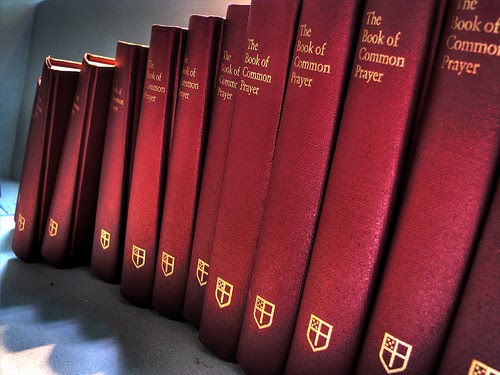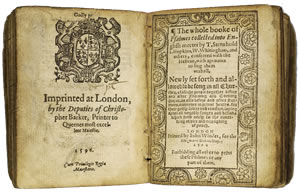 “Those who don’t read have no advantage over those who can’t read.” — Mark Twain
“Those who don’t read have no advantage over those who can’t read.” — Mark Twain
For Anglican purposes, you could (less poignantly) restate Mark Twain’s quote by saying, “Those who don’t use their prayer books have no advantage over those who can’t.” Myself and others could go on and on about the beauty of the language, the importance of communal worship and prayer, the strength of the Catholic & Patristic tradition, the wisdom of Benedictine/Monastic spirituality, the benefit of an aesetical approach to growth in holiness….
Yet, if people don’t understand their prayer books and how to use them, and further if they don’t actually use them, it is all for naught. Dr. Derek Olsen has written something recently along similar lines. Some of his more helpful thoughts include
So—in a nutshell, here’s how I’d go about doing it. First a big-picture, then attention to some of the actual parts.
- Christianity has a variety of valid spiritualities—the BCP enshrines one of them: the liturgical system [and I’d add /sacramental] approach
- The key logic operative here is the disciplined recollection of God with the intention that following these disciplines will lead to the habitual recollection of God.
The fundamental mechanisms for achieving this goal are threefold:
- The kalendar which leads us to view time through a salvific lens
- The Daily Office which is fundamentally catechetical in nature
- The Eucharist which is fundamentally mystagogical in nature
I especially like his thoughts about the recollection of God. It reminds me of Eastern Orthodox ideas about “mindfulness.”
So—here’s why this is important and the meat of how it relates to the issue at hand. The purpose of any spiritual system is to bring the practitioner and their community into a deeper relationship with God—to create a family of mature Christians. Through their increasing awareness of who God is, how much God loves them and all of creation, they translate that love they have been shown into concrete acts of love and mercy in the world around them. There are several different strategies that different spiritual systems use to accomplish this. One of the classic ones—referred to in St Paul’s direction to “pray without ceasing” (1 Thess 5:17)—is the recollection of God. The idea here is that if we can continually keep in mind the goodness of God, the constant presence of God, and an awareness of the mighty works of God on behalf of us and others, that we will more naturally and more completely act in accordance with God’s will and ways. Continual recollection is nearly impossible, but there are methods to help us in this habit.
A primary goal of liturgical spirituality is to create a disciplined recollection of God. Thus, if we specifically pause at central points of time—morning and evening; noon and night; Sundays and other Holy Days—to reorient ourselves towards God and the mighty acts of God, whether recalled to us through the Scriptures or experienced by us through direct encounters with the sacraments, then this discipline will lead us towards a habitual recollection of God.
In the liturgical round, the Book of Common Prayer gives us specific moments to stop and orient our time and ourselves around the recollection of God. As a result, one of the most important parts of the book is the Daily Office section that provides forms for prayer at morning, noon, evening and night. These prayer offices are our fundamental tool for disciplined recollection; they provide the foundation for our spiritual practice. This foundation, then, is punctuated by the Eucharist on Holy Days (at the least). And, conceptually, this is how we should view Sundays—not the day of the week on which we go to church—but as a Holy Day which recurs on a weekly basis.
With all of that in mind, here are a few of my suggestions for making the BCP part of your life and the life of your parish.
1. Create Prayer Book Studies similar to Bible studies. Study the Church Kalendar. Study the various liturgies. Think about why various Scripture readings are chosen for certain occasions. Try to discern what the Prayerbook teaches about ordination, baptism, creation, marriage, etc., etc. Read commentaries on the prayer book(s). And don’t forget to spend time in the “Historical Documents”, especially the 39 articles. If done properly, study of the Prayer Book(s) can be a very rewarding, life-long process of not only learning but spiritual formation and growth.
2. Develop a lay “officers” program at your parish to encourage the public praying of the office daily. If you can get 30 officer volunteers trained and licensed, then you can have the office said daily in your parish with only a once-a-month commitment from each volunteer. If you can get 60 officers trained, then you can have morning and evening prayer daily in your parish without overburdening the clergy, without running your volunteers ragged, and all the while increasing lay involvement and public worship. Ring the bell. If you don’t have one, get one.
3. Make sure basic, but thorough Prayer Book education is part of the confirmation curriculum. Shame on the parish whose confirmands have no idea how to navigate the office or the lectionary, or are lost if the whole service isn’t printed for them on Sunday. Do more than tell them it was compiled by Cranmer, revised in 1979, that we now use the Revised Common Lectionary for xyz reasons, yada yada yada. That information is important, but it isn’t vital. Praying and worshiping is vital. Printing the Sunday liturgy is fine, but all Anglicans should learn to use the prayer book with their eyes closed.
4. Make sure the actual Book of Common Prayer is the foundation and de facto form of worship in your parish. Books of alternative services, books of occasional services, and the like are fine, but they are exactly that: alternative and occasional. They should never be the meat and potatoes of Anglican spiritual formation and worship. If the liturgy you regularly use on Sunday (Eucharistic prayers, Prayers of the People, etc.) is not found in The Book of Common Prayer, don’t be surprised if the parishioners can’t articulate to their neighbors what it means to be an Anglican Christian, and don’t be surprised if they leave your parish when the next cool thing comes to town. If you treat the church like a commodity on the religious marketplace, don’t be surprised if people respond in kind.





